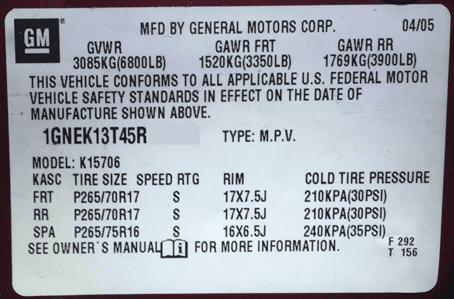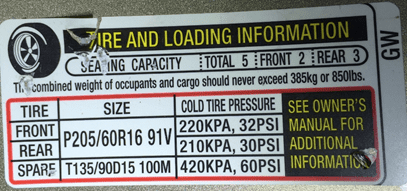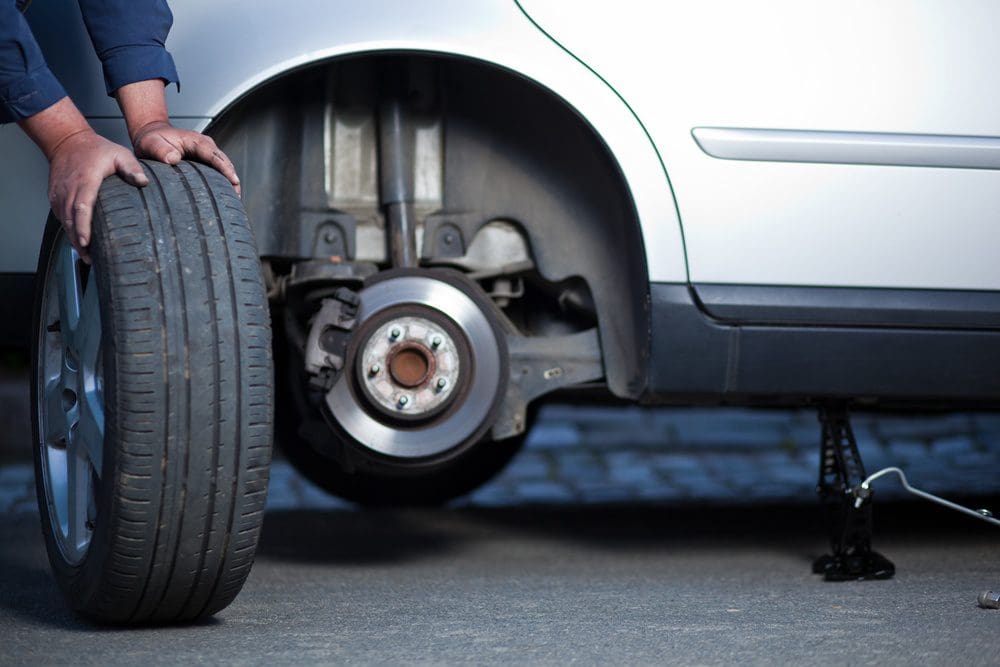There’s a lot of information about tires, far beyond the reviews and recommendations on a variety of websites. Here we’ll talk about, from a post-collision perspective, car specifications, standard tire information, and how tire pressure monitoring systems (TPMS) work. We will then analyze how tire pressures relate to automotive collisions.
Table of Contents
Vehicle Specifications
Vehicles offered in the United States have a placard in the driver’s door jamb or internal door. This placard contains some advice we need to explore the tires including the vehicle manufacturer recommended load rating tire size, and tire pressure. Here’s an example:

(there’s a second placard particularly for tires but this should be supported contrary to the above mentioned placard as the next one does not include any vehicle identifying information such as a VIN. In this picture the last six digits of the VIN have been omitted.)

Tire Size
The majority of modern tires have writing on the sidewall which explains the tires measurements as well as other critical characteristics. What does it imply? Sizes for front and back are recorded. The 265 is the width, in millimeters, of the face. The next number, 70, is that the height of the tire sidewall for a percentage of the tread face (in this instance 70 percent of those 265). The “R” creates the tire structure a radial. Finally, the 17 is sized diameter in inches.
Tire Pressure
Notice that the listed tire pressure is assumed to be chilly. Tires have to sit at least eight hours from direct sunlight before they are deemed enough. Gases expand as they are heated and also the minimal cold pressure is put so that the scooter will be at the optimal pressure once at operating temperature; accordingly, if a bicycle is at or below the minimum and is at operating temperature, the strain was lower when the tire was cold.
Tire Pressure Monitoring System (TPMS)
The TPMS became a mandated normal after the fallout of the Ford Explorer & Firestone bicycle event. The federal government needed a system that would alert drivers to “non” tire pressure(s). There are two types of systems. The first type is called “direct measurement” and it uses a detector inside each tire which relays the strain. The second kind is known as “indirect dimension” and it utilizes the anti-lock brake method to determine if a tire is spinning faster than others. A bicycle with air pressure that is less will have a diameter that is smaller and will spin faster; this difference can be calculated by the brake system.
The gap in either system comes when we examine how this system decides to warn the motorist. Because the pressures at a tire can differ for a few reasons (we only discussed how temperature is one of these) that the TPMS doesn’t search for a single pressure, but rather an array or minimum strain. The setup within the computer of the vehicle only illuminates the warning light when a tire’s pressure is outside the specifications that are preselected.
Many studies by the national authorities, independent organizations, and tire producers all support substandard performance of tires where the tires are below the recommended pressure. The research have three points of discussion.
- 71 percent of drivers check tire pressure less than a month.
- More than 1/3 of passenger cars surveyed had at least one tire at or below 20 percent of their placard.
- Only 36 percent of vehicles tested would find a warning light at 20 percent or more below the placard.
The first point is not a surprise. The absence of frequent tire pressure maintenance is part of why the federal government mandated the TPMS system. The next point is also not surprising. If the majority (71%) does not regularly check tire pressure, it should be anticipated tires are below the recommended pressure. The point is that the one we want to concentrate on. We want to focus on this fact since the majority of passenger car worries are 30 PSI; 20 percent less is 24 PSI.
If 100 passenger vehicles were on the road, 36 of these would have a minumum of one tire at 20% below the placard pressure. Of those 36 vehicles, just 13 of them would have a warning light. (For the record it’s not much better for your light truck / SUV category.)
So now we know a third of those vehicles on the street have an underinflated tire and additional only a third of those vehicles have a warning light. The question is does 6 PSI thing? Yes, it does. Testing done by Goodyear and the NHTSA supported decrease in managing a reduction in pressure results in greater stopping distances, increase in blowouts, lower fuel economy, and tire wear.
Putting it All Together
The National Highway Transportation Safety Administration (NHTSA) also regularly studies tire related accidents. 1 study found approximately 9 percent of all collisions are tire related. In 2012, out of the 5.6 million authorities reported accidents, 504,000 were related.
For simplicity, we will assume each the accidents involved one car making the total 5.6 million. 725,000 would possess the warning lighting if we utilize the proportions more than 2 million would have at least one tire that is underinflated, in the table. Increasing the amount of vehicles only increases the statistics.
When deciding causality, you will find 504,000 tire related collisions as reported previously and also this misunderstood and often overlooked fact is omitted when attempting to determine the culpable party. It’s because of this that upkeep that tire pressures should be ascertained immediately post-accident rather than only focus on skid marks (though they are equally important in the equation important) because demonstrative evidence when trying to reconstruct accidents in the pursuit of discovering causality.
In Part 2 we will discuss how these variables affect tire performance that further provides demonstrative evidence to the accident reconstructionist, accident investigator and lawyer.
The scope of our information is limited to chiropractic and spinal injuries and conditions. To discuss options on the subject matter, please feel free to ask Dr. Jimenez or contact us at 915-850-0900 . 
References
National Highway Transportation Safety Administration. (2012). Traffic Safety Facts 2012. Retrieved from http://www-nrd.nhtsa.dot.gov/Pubs/812032.pdf
National Highway Transportation Safety Administration. (2013, june 28). SAFETY ADVISORY: NHTSA Urges Drivers to Check Tires During Hot Weather. Retrieved from http://www.nhtsa.gov/About+NHTSA/Press+Releases/SAFETY+ADVISORY:+NHTSA+Urges+Drivers+to+Check+Tires+During+Hot+Weather
National Highway Transportation Safety Administration. (2013, June). The Problem. Retrieved from http://www.nhtsa.gov/nhtsa/Safety1nNum3ers/june2013/theProblemJune2013.html
National Highway Transportation Safety Administration. (n.d.). TIRE PRESSURE SURVEY AND TEST RESULTS. Retrieved from http://www.nhtsa.gov/cars/rules/rulings/TirePressure/LTPW3.html
National Highway Transportation Safety Administration. (n.d.). Tire Pressure Final. Retrieved from http://www.nhtsa.gov/cars/rules/rulings/tirepresfinal/safetypr.html
Additional Topics: Auto Injury Playlist
Whiplash is a commonly reported injury after an individual has been involved in an automobile accident. During an auto accident, the sheer force of the impact often causes the head and neck of the victim to jerk abruptly, back-and-forth, causing damage to the complex structures surrounding the cervical spine. Chiropractic care is a safe and effective, alternative treatment option utilized to help decrease the symptoms of whiplash.

TRENDING TOPIC: EXTRA EXTRA: New PUSH 24/7®️ Fitness Center
Post Disclaimer
Professional Scope of Practice *
The information on this blog site is not intended to replace a one-on-one relationship with a qualified healthcare professional or licensed physician and is not medical advice. We encourage you to make healthcare decisions based on your research and partnership with a qualified healthcare professional.
Blog Information & Scope Discussions
Welcome to El Paso's Premier Wellness and Injury Care Clinic & Wellness Blog, where Dr. Alex Jimenez, DC, FNP-C, a board-certified Family Practice Nurse Practitioner (FNP-BC) and Chiropractor (DC), presents insights on how our team is dedicated to holistic healing and personalized care. Our practice aligns with evidence-based treatment protocols inspired by integrative medicine principles, similar to those found on this site and our family practice-based chiromed.com site, focusing on restoring health naturally for patients of all ages.
Our areas of chiropractic practice include Wellness & Nutrition, Chronic Pain, Personal Injury, Auto Accident Care, Work Injuries, Back Injury, Low Back Pain, Neck Pain, Migraine Headaches, Sports Injuries, Severe Sciatica, Scoliosis, Complex Herniated Discs, Fibromyalgia, Chronic Pain, Complex Injuries, Stress Management, Functional Medicine Treatments, and in-scope care protocols.
Our information scope is limited to chiropractic, musculoskeletal, physical medicine, wellness, contributing etiological viscerosomatic disturbances within clinical presentations, associated somato-visceral reflex clinical dynamics, subluxation complexes, sensitive health issues, and functional medicine articles, topics, and discussions.
We provide and present clinical collaboration with specialists from various disciplines. Each specialist is governed by their professional scope of practice and their jurisdiction of licensure. We use functional health & wellness protocols to treat and support care for the injuries or disorders of the musculoskeletal system.
Our videos, posts, topics, subjects, and insights cover clinical matters and issues that relate to and directly or indirectly support our clinical scope of practice.*
Our office has made a reasonable effort to provide supportive citations and has identified relevant research studies that support our posts. We provide copies of supporting research studies available to regulatory boards and the public upon request.
We understand that we cover matters that require an additional explanation of how they may assist in a particular care plan or treatment protocol; therefore, to discuss the subject matter above further, please feel free to ask Dr. Alex Jimenez, DC, APRN, FNP-BC, or contact us at 915-850-0900.
We are here to help you and your family.
Blessings
Dr. Alex Jimenez DC, MSACP, APRN, FNP-BC*, CCST, IFMCP, CFMP, ATN
email: coach@elpasofunctionalmedicine.com
Licensed as a Doctor of Chiropractic (DC) in Texas & New Mexico*
Texas DC License # TX5807
New Mexico DC License # NM-DC2182
Licensed as a Registered Nurse (RN*) in Texas & Multistate
Texas RN License # 1191402
ANCC FNP-BC: Board Certified Nurse Practitioner*
Compact Status: Multi-State License: Authorized to Practice in 40 States*
Graduate with Honors: ICHS: MSN-FNP (Family Nurse Practitioner Program)
Degree Granted. Master's in Family Practice MSN Diploma (Cum Laude)
Dr. Alex Jimenez, DC, APRN, FNP-BC*, CFMP, IFMCP, ATN, CCST
My Digital Business Card


